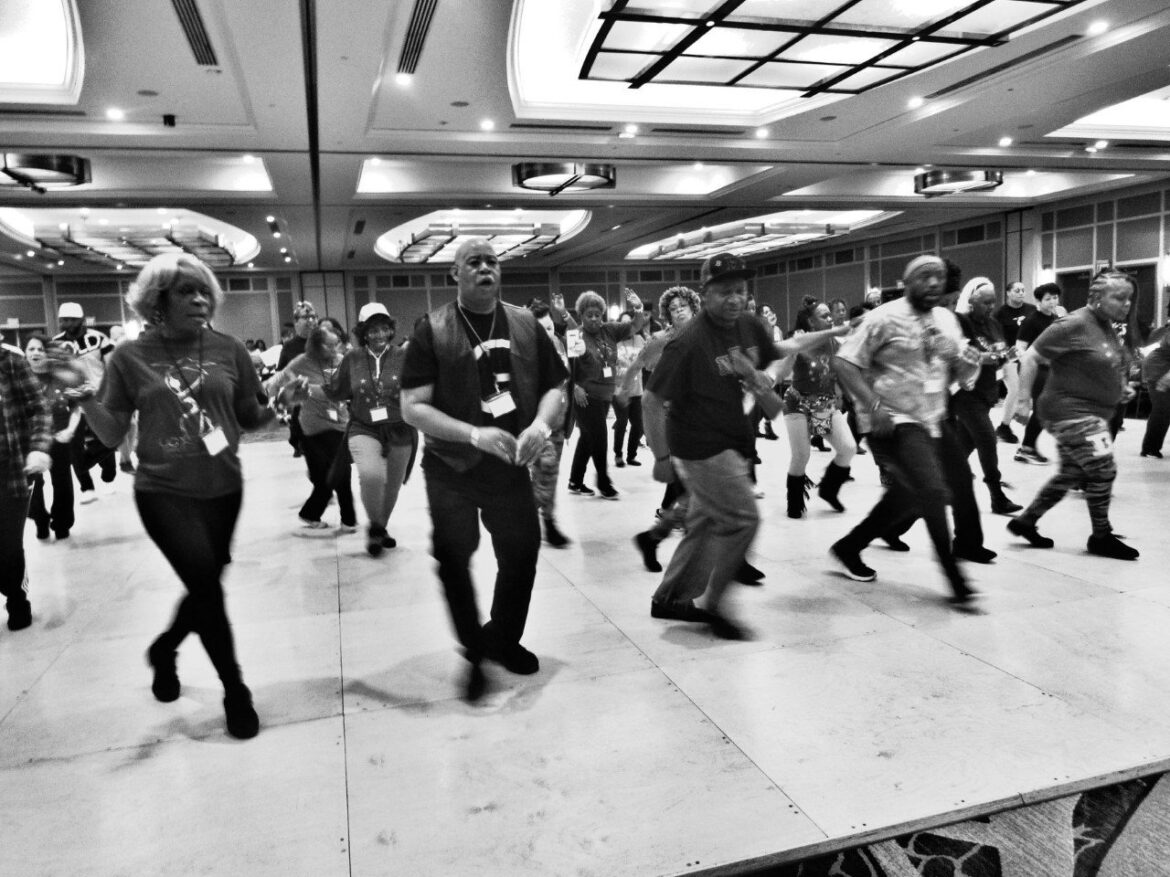💃✨ Brussels’ Sugar Pie Line Dance with Jazya & Eda ✨🕺
Do you want to learn a community choreography, and then surprise everyone by popping up on the dance floor during the Blues Remix parties?
Jazya & Eda brought together a joyful line dance choreography just for Blues Remix, mixing heritage, groove, and community fun.
We are inspired by two powerhouse songs:
🎶 Slip-In Mules by Sugar Pie DeSanto — a fiery Blues & R&B singer born Umpeylia Marsema Balinton (1935). A trailblazer of the 1950s–60s, she toured with James Brown, recorded for Chess Records, and became known for her explosive stage energy, raspy voice, and fearless spirit.
🎶 Voodoo Woman by Koko Taylor — the “Queen of the Blues,” whose raw voice and Chicago grit made her one of the most iconic women in Blues history.
Whenever you hear these tracks at the parties, it’s your turn to jump in and join the flashmob!
🪩 The choreography “Sugar Pie” honors the roots of Blues and beyond, weaving in steps you might recognize.
Line Dances & the Electric Slide Connection
Line dancing has always been part of African American social culture, from early Blues and Jazz steps to today’s dance floors. In the 1920s and 30s, rent parties and juke joints often featured group dances built from shared vocabulary like the Suzy Q, Fishtail, or Mess Around. These were community dances, everyone could join, regardless of partner.
The tradition carried forward into Rhythm & Blues, Funk, and Soul, eventually giving birth to iconic line dances such as the Electric Slide in the 1970s. Created by choreographer Ric Silver in 1976 to Marcia Griffiths’ Electric Boogie, the dance became a global phenomenon. Its roots, however, remain deeply tied to the Blues and Jazz lineage: pulsed steps, slides, shuffles, and improvisational breaks echo the same African American vernacular vocabulary that animated earlier social dances.
When we bring the Electric Slide spirit into Blues Remix, we honor that continuity, showing that line dances are not just “party fun” but part of a living tradition where community, groove, and joy have always been at the center.
In this choreography the steps we included are:
1. Cross Walk
- Origin: African American vernacular dance (1920s–40s), stylized struts from everyday walking.
- Look & Feel: Traveling cross-step with grounded hips and torso, elegant yet earthy.
- Context: Seen in Blues and Jazz social dances — dancers turned daily gestures into rhythm and style.
2. Suzy Q
- Origin: Harlem ballrooms, late 1920s; spread through Lindy Hop, tap, and jazz repertoires.
- Look & Feel: Crossing/swiveling feet with syncopated hip twists. Sassy and rhythmic.
- Context: Used as a flashy step in solo jazz routines and floor-shines.
3. Mambo
- Origin: Cuba, 1930s (Orestes & Israel “Cachao” López), expanded in NY’s Palladium Ballroom (1940s–50s).
- Look & Feel: Syncopated Afro-Cuban pulse, forward/back steps, torso and hip articulation.
- Context: Afro-Cuban/Jazz fusion dance that shaped salsa and influenced crossover Blues dancing.
4. Hallelujah
- Origin: African American church worship; gospel/spiritual ecstatic movement.
- Look & Feel: Expansive release , raised arms, lifted chest, feet pulsing with joy.
- Context: Shows the sacred-secular continuum in African American culture; adapted into jazz dance styling.
5. Fishtail
- Origin: Blues and Swing-era social dance (1920s–40s).
- Look & Feel: Knees swivel inward/outward, hips swaying side-to-side. Smooth and sensual.
- Context: Used in slow drag, swing, and later boogie-woogie. Embodied grounded groove.
6. Boogie Forward
- Origin: Boogie Woogie and Rhythm & Blues line dances (1930s–50s).
- Look & Feel: Traveling forward with pulsed knees, strutting hips, confident groove.
- Context: Show-off step in group line dances and solo jams.
7. Mess Around
- Origin: Blues juke joints and barrelhouse dancing, popularized in early R&B songs (e.g. Ray Charles, Mess Around 1953).
- Look & Feel: Circular hip rotations, playful torso movements, improvisational groove.
- Context: Symbol of “cutting loose” — often inserted in line dances as a fun, party step.
8. Mooches
- Origin: Named after Duke Ellington’s 1928 song The Mooche.
- Look & Feel: Dragging, pulsed walk with hip rolls and expressive upper body styling.
- Context: A bluesy strut full of character; became iconic in both partnered and solo jazz repertoires.
9. Break
- Origin: Jazz “breaks” in music and dance — moments of pause/improvisation.
- Look & Feel: Sudden stop, freeze, or accent; improvisation encouraged.
- Context: Where dancers shine individually; a core feature of Blues/Swing aesthetics.
10. Pulse
- Origin: Africanist movement aesthetic — “the get down” — carried into all African American dances.
- Look & Feel: Continuous grounded bounce in knees and hips.
- Context: The heartbeat of Blues and Swing — more than a step, it’s the base groove.
11. Kicks
- Origin: Charleston (1920s) and later Lindy Hop/R&B line dances.
- Look & Feel: Sharp or syncopated kicks forward/side, sometimes exaggerated or theatrical.
- Context: Used in chorus lines, jam circles, and line dances for showmanship.
This article was written by Eda Ozdek for Blues Remix, 2025
References
- Brooks, Daphne A. Bodies in Dissent: Spectacular Performances of Race and Freedom, 1850–1910. Duke University Press, 2006.
- Dixon-Gottschild, Brenda. Digging the Africanist Presence in American Performance. Greenwood Press, 1996.
- Emery, Lynne Fauley. Black Dance: From 1619 to Today. 2nd ed., Princeton Book Company, 1988.
- Floyd, Samuel A. The Power of Black Music: Interpreting Its History from Africa to the United States. Oxford University Press, 1995.
- Lomax, Alan. The Land Where the Blues Began. Pantheon, 1993.
- Manning, Frankie, and Cynthia Millman. Frankie Manning: Ambassador of Lindy Hop. Temple University Press, 2007.
- Malone, Jacqui. Steppin’ on the Blues: The Visible Rhythms of African American Dance. University of Illinois Press, 1996.
- Peiss, Kathy. Cheap Amusements: Working Women and Leisure in Turn-of-the-Century New York. Temple University Press, 1986.
- Roberts, John Storm. The Latin Tinge: The Impact of Latin American Music on the United States. Oxford University Press, 1979.
- Silver, Ric. “The Electric Slide (The Electric Boogie Line Dance).” Original choreography notes, 1976.
- Stearns, Marshall, and Jean Stearns. Jazz Dance: The Story of American Vernacular Dance. Da Capo Press, 1994.
- Stearns, Marshall. The Story of Jazz. Oxford University Press, 1956.
- Sublette, Ned. Cuba and Its Music: From the First Drums to the Mambo. Chicago Review Press, 2004.
- Thompson, Robert Farris. African Art in Motion. University of California Press, 1974.
- Tucker, Sherrie. Swing Shift: “All-Girl” Bands of the 1940s. Duke University Press, 2000.
- Griffiths, Marcia. Interview on Electric Boogie and the spread of the Electric Slide, NPR, 2003.
- https://allisonveneziowrites.com/2019/07/09/electric-slide/
Photo credit: Marcia Griffiths, Graham Wood/Evening Standard/


